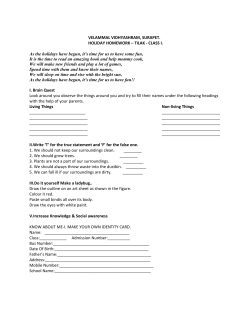
Helping Your Child Learn Math Fayetteville Elementary School November 17, 2011
Helping Your Child Learn Math Fayetteville Elementary School November 17, 2011 Why is math important? • At home – We use math in many ways – from cooking meals and making repairs to checking the weather forecast so we’ll know what to wear. • At work – Math is used in almost every job – from counting change to designing machines. • At play – Math is used in lots of fun ways – from solving puzzles to keeping score. Parents can help children succeed in math. • Have a positive attitude about math – even if you didn’t like it in school. Children need to feel good about math. If you say, “I hated math” or “I can’t do math,” your child may start to feel the same way. • Point out examples of how people use math in daily life. • Show interest in your child’s math homework – and be on hand to help. (Try not to worry about your math skills – you probably know more than you think. • Encourage activities that make math interesting and fun! Put out the welcome mat for math! • Have these on hand in your home: – Games • Board games, dice, cards, bingo, dominoes, etc., can help children learn math while having fun. – Toys • Construction sets, blocks, puzzles and other toys can help younger children explore shapes, area and volume. • Have these on hand in your home: – Small objects • Children in primary grades can sort, count, stack or arrange these by shapes. Some objects they can use are: – – – – – Buttons Coins Checkers Dried beans Toothpicks. These objects can also help older children solve math problems. – A ruler and tape measure • Let your child have fun measuring familiar objects. • Have these on hand in your home: – A calculator • Your child can use it for solving more complex math problems. An inexpensive model is usually fine. • Read the instructions together and try out the functions. If sample problems are given, practice them to get comfortable with the calculator. – A computer • Your child can use it to access math Web sites on the internet, and to use math software to learn math skills. If you don’t have a computer at home, visit the local library where access is available. Math Websites http://www.coolmath4kids.com Cool math 4 kids is a math site specially designed for what kids like and how they learn! Math really CAN be fun and really CAN be easy to learn. There are lots of lessons and games on the site(s) to make math fun! http://mathworld.wolfram.com/ "The Web's most extensive mathematics resource" will help you remember all the algebra, geometry, trig, statistics, calculus, and diffie-Q that you left behind years ago! And you'll probably learn a lot you never knew along the way. http://www.multiplication.com This site contains the techniques, tips, and secrets used by master teachers! http://www.mathcats.com/index.html#contents Math Cats is a land of creative, open-ended, math explorations. http://ww.harcourtschool.com/activity/that_a_fact/english_K_3.html Math website to practice math facts. http://nlvm.usu.edu/en/nav/vlibrary.html A wonderful collection of virtual manipulatives that span grade levels from Pre-K to 12 and cover numbers & operations, algebra, geometry, measurement, and data analysis and probability. School teaches math in new ways. • Using hands-on experience – such as drawing pictures to “see the problem or moving cubes that represent numbers. • Estimating – making an “educated guess.” Estimation is used more than any other math skill in daily life. • Using probability and statistics – gathering and interpreting numbers to predict the chances that something will happen. For example: • How many days will it rain this month? • What are your favorite team’s chances of making the playoffs? • Measuring – using different ways to measure all sorts of things, such as: • an object’s height, weight, volume or area • time • temperature. • Applying logic – using reason to figure out a way to solve a problem. • Understanding patterns – recognizing, describing and figuring out what comes next in a sequence of objects or numbers. • Exploring shapes – Learning about circles, ovals, squares, triangles, spheres and other shapes. The magic of math is everywhere! • • • • • In the store While managing money In sports In the kitchen In the car Some test-taking tips • Remind your child to: – Bring supplies. • Having his or her own supplies can make your child feel more relaxed. (#2 pencils) – Follow directions. • Tell your child to listen carefully to the teacher before the test begins. Your child also needs to read all directions on the test itself. – Write neatly. • Sloppy work can lower test scores. Tell your child to fill in circles completely. – Keep an eye on the clock. • To complete the entire test, your child will need to budget his or her time. If there’s time at the end, your child should check his or her answers. – Avoid getting stuck on any one question. • Your child can mark that question and go back to it later. Remind your child to leave a blank space for it on the answer sheet. – Tell your child it’s OK to guess if they do not know an answer. 3rd and 4th grade tests dates: • February 23rd – Spring Math Benchmark Test • April 10th and 11th – ARMT+ Reading • April 12th and 13th – ARMT+ Math
© Copyright 2025





















